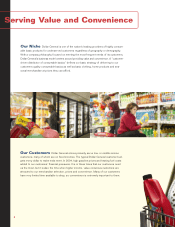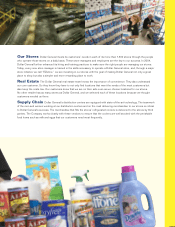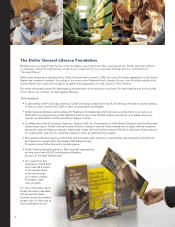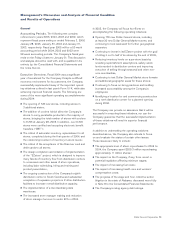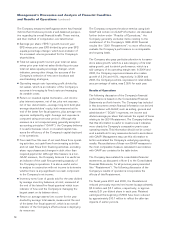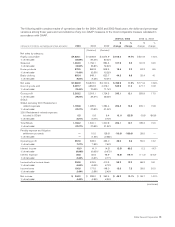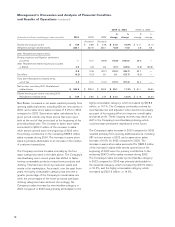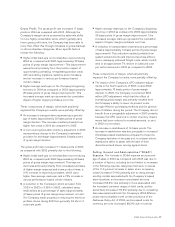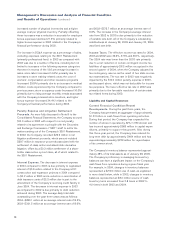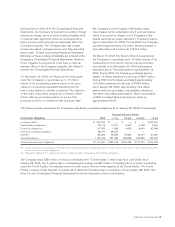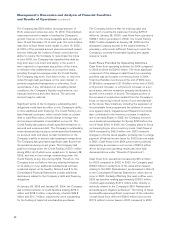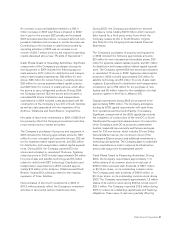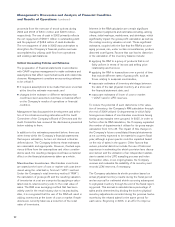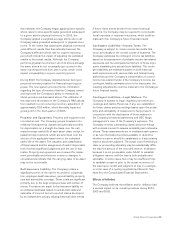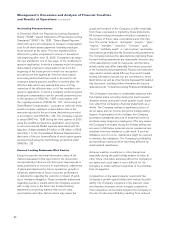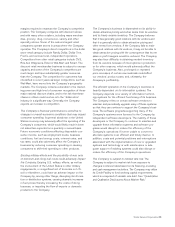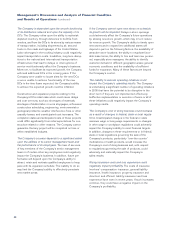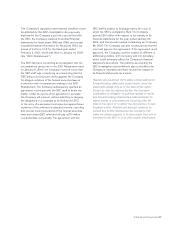Dollar General 2004 Annual Report Download - page 19
Download and view the complete annual report
Please find page 19 of the 2004 Dollar General annual report below. You can navigate through the pages in the report by either clicking on the pages listed below, or by using the keyword search tool below to find specific information within the annual report.Dollar General Corporation 17
Gross Profit. The gross profit rate increased 17 basis
points in 2004 as compared with 2003. Although the
Company’s margin rate is pressured by sales mix shifts
to more highly consumable items, which typically carry
lower gross profit rates, the Company has been able to
more than offset this through increases in gross markups
on all merchandise categories. More specific factors
include the following:
■ Higher initial mark-ups on merchandise received during
2004 as compared with 2003 (approximately 32 basis
points of gross margin improvement). This improvement
was achieved primarily from the positive impact of
opportunistic purchasing, renegotiating product costs
with several key suppliers, selective price increases,
and an increase in various performance-based
vendor rebates.
■ Higher average mark-ups on the Company’s beginning
inventory in 2004 as compared to 2003 (approximately
20 basis points of gross margin improvement). This
increased average mark-up represents the cumulative
impact of higher margin purchases over time.
These components of margin, which both positively
impacted the Company’s results, were partially offset by:
■ An increase in transportation expenses as a percent-
age of sales (approximately 23 basis points of gross
margin decline). This increase resulted primarily from
higher fuel costs in 2004 as compared to 2003.
■ A non-recurring favorable inventory adjustment in 2003
representing a change in the Company’s estimated
provision for shrinkage (approximately 6 basis points
of gross margin decline).
The gross profit rate increased 111 basis points in 2003
as compared with 2002 primarily due to the following:
■ Higher initial mark-ups on merchandise received during
2003 as compared with 2002 (approximately 59 basis
points of gross margin improvement). This improve-
ment was achieved primarily from increased purchases
of higher margin seasonal and home product items; a
31% increase in imported purchases, which carry
higher than average mark-ups; and a 72% increase in
various performance-based vendor rebates.
■ A reduction in the Company’s shrink provision from
3.52% in 2002 to 3.05% in 2003, calculated using
retail dollars as a percentage of sales (approximately
41 basis points of gross margin improvement, at cost).
The Company made progress in reducing the shrink at
problem stores during 2003 but generally fell short of
corporate goals.
■ Higher average mark-ups on the Company’s beginning
inventory in 2003 as compared to 2002 (approximately
18 basis points of gross margin improvement). This
increased average mark-up represents the cumulative
impact of higher margin purchases over time.
■ A reduction in transportation expenses as a percentage
of sales (approximately 14 basis points of gross margin
improvement). This reduction resulted primarily from
system enhancements and improved process efficien-
cies in managing outbound freight costs, which contrib-
uted to an approximate 7% decline in outbound cost
per carton delivered in 2003 as compared to 2002.
These components of margin, which all positively
impacted the Company’s results, were partially offset by:
■ The impact of the Company’s LIFO valuation adjust-
ments in the fourth quarters of 2003 versus 2002
(approximately 16 basis points of gross margin
decline). In 2002, the Company recorded an $8.9
million LIFO adjustment, which had the effect of
increasing gross margin and primarily resulted from
the Company’s ability to lower its product costs
through effective purchasing methods and the general
lack of inflation during the period. The Company did not
benefit from a comparable adjustment in 2003 primarily
because the LIFO reserves in certain inventory depart-
ments had been reduced to nominal amounts, or zero,
in 2002 or prior years.
■ An increase in markdowns of 14 basis points. The
increase in markdowns was due principally to increased
Christmas-related markdowns compared to those the
Company had taken in the past and, to a lesser extent,
markdowns taken to assist with the sale of both
discontinued and slower moving apparel items.
Selling, General and Administrative (“SG&A”)
Expense. The increase in SG&A expense as a percent-
age of sales in 2004 as compared with 2003 was due to
a number of factors, including but not limited to increases
in the following expense categories that were in excess
of the 11.5 percent increase in sales: store occupancy
costs (increased 17.4%) primarily due to rising average
monthly rentals associated with the Company’s leased
store locations; an increase in purchased services
(increased 54.6%) due primarily to fees associated with
the increased customer usage of debit cards; profes-
sional fees (increased 119.2%) primarily due to consulting
fees associated with both the Company’s 2004 EZstore
project and compliance with certain provisions of the
Sarbanes-Oxley Act of 2002; and increased costs for
inventory services (increased 88.2%) due to both an



